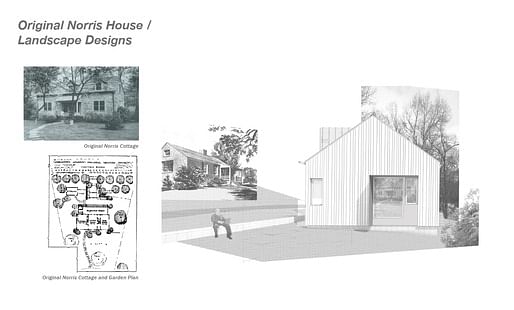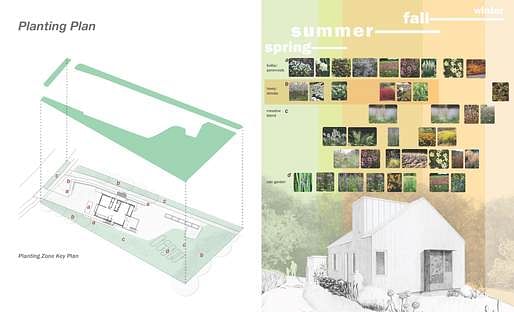
Last week, the New Norris House made an appearance at the TN Chapter of the American Society of Landscape Architects Annual Conference in Nashville, TN. The presentation was geared toward landscape architects, and focused on our landscape design and water harvesting and treatment systems.
We began with an overview of the original town plan, including the greenbelt that protects the community's watershed and the network of walking paths that link individual homes to the town center.

We then looked at the original Norris cottages and landscapes and discussed how we could re-interpret the efficient, technologically advanced homes and the productive, functional landscapes of the original Norris plan into 21st Century standards.

I showed the planting plan, and how we reflected the towns water-guarding greenbelt with our own site-scale native grass meadow, which is designed to capture and infiltrate storm water sheet flow.

We then looked at the locations and functions of our integrated rainwater harvesting and treatment and greywater treatment systems.

Now that we have a year's worth of data on the water systems, I explained what we are learning. Our data shows that we have been able to reuse about 1,990 gallons of greywater for landscape irrigation per month. Over the course of the previous year, we were able to infiltrate almost 24,000 gallons of greywater into the groundwater table, keeping that water out of a waste-water treatment facility. We are also monitoring the infiltration rates of our greywater. In the graph below the red, green, and dark blue lines represent data from pressure sensors located in the greywater bed. The spikes show an increase in atmospheric pressure, which indicates water entering the bed. Each spike represents an influx of water into the bed, so we are most likely seeing showers and loads of laundry here.

We also looked at data on the rainwater quality and quantity. Our monthly pre- and post-treatment rainwater samples are showing that our treatment system is able to produce water that is safe for human contact per EPA human health criteria.

In terms of rain water quantity, we have been able to provide over 800 gallons of treated rain water for use on the home each month. That's almost 10,000 gallons a year! However, due to the size of our cistern and weather and use patterns, we are only using about 40% of the rain water that falls on our roof in the home. The other 60% (about 15,000 gallons) is used for vegetable garden irrigation or is infiltrated into our terraced rain gardens.

With our low-flow water fixtures and rainwater supply, we have been able to reduce the New Norris House potable water consumption by 68.5%. If all of the approximately 700 homes in Norris were able to reduce their municipal water demand by New Norris House standards, we could save over 25million gallons of water a year. That's 34 Olympic-sized pools!

One question asked after the presentation was what I thought was the biggest lesson learned from our data analysis. I think that what we are learning about the successful infiltration in the greywater bed is most interesting. Due to our clay soils and location on a slope, I am very pleased to see how well this bed is performing. Also, the greywater bed is one of the least expensive landscape features we designed, so it could be easily reproduced on other properties. Way to go, greywater bed!
The New Norris House is a design/build effort from the University of Tennessee's College of Architecture and Design. Began in 2009, the home was designed and built by UT students in collaboration with Clayton Homes. The built project is now complete and the final phase of the project has begun. A team of 4 people (2 living in the home, and 2 graduate researchers) will rigorously document the experience via qualitative assessments and quantitative measurements, posting results to this blog.





No Comments
Block this user
Are you sure you want to block this user and hide all related comments throughout the site?
Archinect
This is your first comment on Archinect. Your comment will be visible once approved.